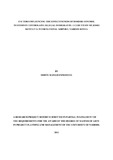| dc.description.abstract | The aim of this study was to investigate factors influencing the effectiveness of border control
systems in controlling illegal immigrants. Effective border management at the points of entry
enhances security of the country. At the points of entry is where persons traveling on forged
documents, lost passports, drug traffickers, terrorists, human traffickers are identified. There are
three main outcomes of border security that contribute to preventing illegal migration, and they
reflect fundamental border-security capabilities of interdiction, deterrence, and networked
intelligence. In many ways, the outcomes mirror the drug-control outcomes, but some important
differences arise that require careful consideration. The objectives of the study are to assess the
extent to which availability of technical team influences the effectiveness of border control
systems in controlling illegal immigrants in Kenya, To determine how management support
influences the effectiveness of border control systems in controlling illegal immigrants in Kenya,
To determine how capability of PISCES influences the effectiveness of border control systems in
controlling illegal immigrants in Kenya and To determine how government laws influences the
effectiveness of border control systems in controlling illegal immigrants in Kenya. A descriptive
study design is the best design to be used to fulfill the objectives of the study. The research used
simple random sampling methods by selecting a given number of subjects from a defined
population as representative of that population. The researcher used stratified random sampling
technique to select a sample size of 55 employees from the population 176 borders control staff
from the Jomo Kenyatta International Airport. Data was collected, examined and checked for
completeness and clarity. Descriptive statistics was used to analyze the data. Data was analyzed
using tables, percentages, means and standard deviations. Statistical Package on Social Sciences
version 17 was used in statistical analysis. The study provides data to assist researchers,
development practitioners, academicians, policy makers, planners and programme implementers
as well a larger society in reducing violent behavior. The study established that there was a
technical team in place working on the project for control systems. Project Teamwork and
composition was found to be very important throughout the project life cycle. It was also
revealed that the world’s population exerts pressure on a country’s economic resources,
education, employment, poor remuneration, destruction of the environment, insecurity and
political instability. Another finding is that the world’s population exerts pressure on a country’s
economic resources, education, employment, poor remuneration, destruction of the environment,
insecurity and political instability. The study results show that the purpose of border enforcement
is not just to apprehend would-be border crosses, but to raise the costs for potential crosses and
thus deter others from ever attempting illegal entry. | en_US |

